We explain what the Spanish Civil War was, its causes and consequences. In addition, we discuss its characteristics, and the role of the Church.
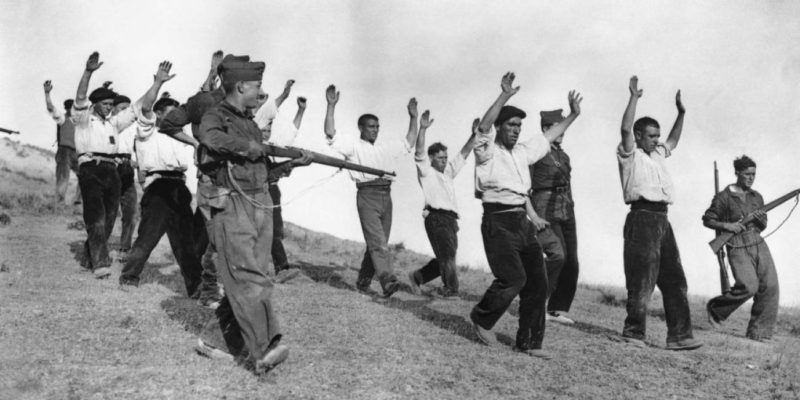
What was the Spanish Civil War?
The Spanish Civil War is the name given to the armed conflict that took place in Spain between July 17, 1936 and April 1, 1939. In this conflict, the legitimately constituted government of the Second Spanish Republic fought various factions of the insurgent Spanish army.
The Spanish Civil War stands as a convoluted chapter in Spanish history. Many historians define it as an armed class struggle, intersected by different ideological dimensions: dictatorship versus republic, fascism versus communism, and religious nationalism against secular socialism.
The insurgent military forces were led by General Francisco Franco, who, after triumphing in battle, became the caudillo and dictator of Spain until his death in 1975. Under his dictatorial regime, repression and suppression of Spanish socialism, communism and anarchism took place.
Described as a prelude to World War II, the Spanish Civil War represented one of the most tragic war events in European history during the first half of the 20th century. In this conflict, around 500,000 lives were lost, and the country was subdued in a totalitarian and brutal regime that lasted 36 years.
- See also: History of the European Union
Background of the Spanish Civil War
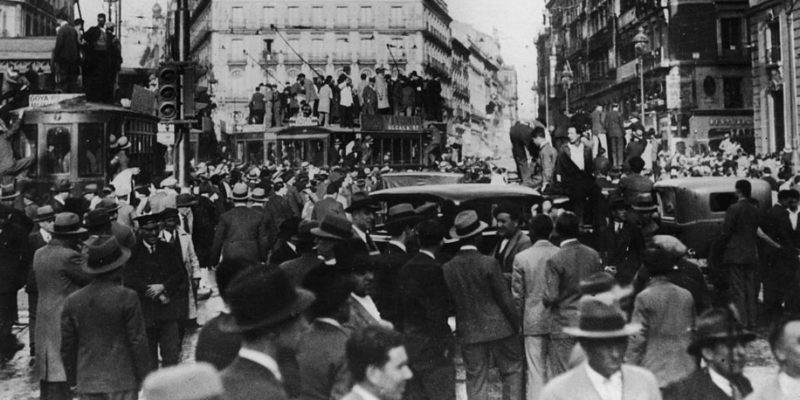
Since the beginning of the 20th century, with the triumph of the Russian Revolution in 1917, a great fear of communism had spread among the European upper classes. In Spain, King Alfonso XIII and the army began to actively intervene in politics, with the aim of neutralizing the rise or actions of communist groups.
In 1923, General Miguel Primo de Rivera led a coup d'état and established a de facto government. Subsequently, he founded the Patriotic Union Party to legitimize his regime and sought to form political corporations to replace the traditional political parties.
In response to the dictatorial government of Primo de Rivera, a heterogeneous opposition was formed involving various segments of society: intellectual elites, workers' groups, republican supporters, university students, and left-wing militants. Due to the pressure exerted by these groups, the king and the army withdrew their support to the government and Primo de Rivera called elections in 1931.
Second Spanish Republic
The Revolutionary Committee, composed of Socialists and Republicans, won the elections and proclaimed the so-called Second Spanish Republic. The new government sanctioned a new constitution and promoted structural political, economic and societal reforms. Among the most significant were the separation of Church and State, the expropriation of lands from large landowners and their distribution among the poor peasantry, and state intervention in the defense of workers' rights against bourgeois business owners.
As a result, the various groups that were affected by these measures came together as a large opposition, which included the Church, supporters of the monarchy, conservative groups, aristocratic landowners, and the Army.
The end of the Second Republic
In the 1936 elections, a coalition composed of communist, socialist, and left-wing republican parties, known as the Popular Front, triumphed. In response, military groups backed by the opposition attempted a coup d'état, which was dismantled by the new government.
However, in July, General Francisco Franco initiated a second uprising, with the support of the Church, the landowning upper classes, and monarchist groups. His campaign proclaimed the defense of private property, the Nation, the family, and religion.
Franco's insurrection received considerable support but did not achieve immediate success. From that moment, a civil war began between the Republican and the Nationalist forces.
Opposing factions
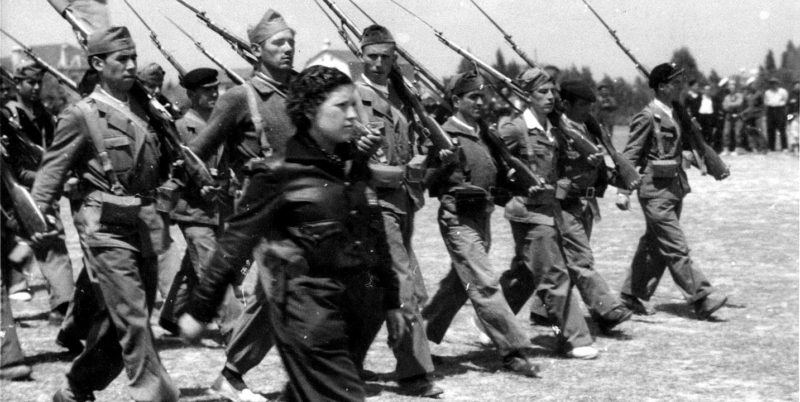
In the Spanish Civil War, two factions clashed:
- The Republican forces. They were composed of groups aligned with the constitutional government led by the Popular Front. They included the republican parties, joined by the Spanish Socialist Workers' Party, as well as anarchist, syndicalist, and communist groups. They were supported by the peasantry, the proletariat, and the Basque and Catalan autonomous movements.
- The rebel Nationalist forces. They represented the monarchist groups, landowners, conservatives, the Church, and the upper bourgeoisie. They were organized around the high military command, forming the Junta de Defensa Nacional (National Defence Council), chaired by Generalísimo Francisco Franco, appointed Head of State of insurgent Spain. This faction comprised conservative political movements such as the Falange Española Spanish Falange), and the Confederación Española de Derechas Autónomas; CEDA (Confederation of Autonomous Rights), and received the support of the Catholic Church and business elites.
International situation
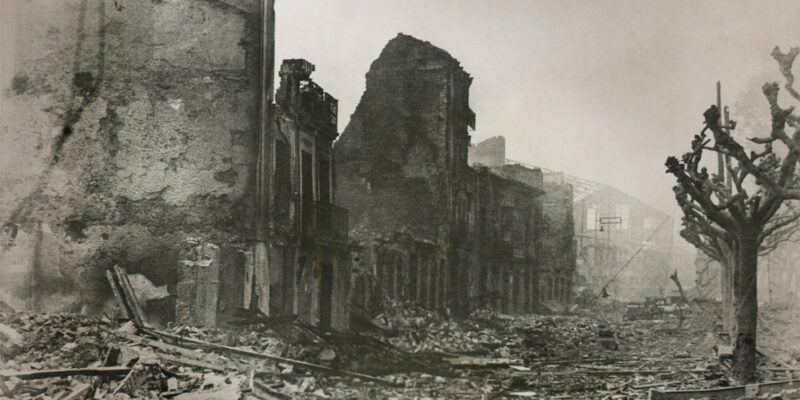
Although fear of communism was spread across all Europe, the powers adopted different stances concerning the Spanish conflict. In 1936, France, England, Germany, and Italy set up the Non-Intervention Committee and agreed not to get involved in the Spanish Civil War.
This position of neutrality was spurred by France and England. However, months later, Germany and Italy broke the pact and became entangled in the conflict.
The Nationalist rebels received direct support from the totalitarian governments of Italy and Germany. Benito Mussolini and Adolf Hitler sought to defeat all left-wing governments and sent military assistance. Intervention heightened, and in 1937, the German air force bombed the city of Guernica.
The Republican government received no help from the European democracies: France and England remained neutral. The only countries that supported them were the USSR and Mexico, which assisted the Republicans politically, diplomatically, and with military resources.
Furthermore, an international coalition of European communist parties, known as the International Brigades, was formed. These brigades were made up of civilians from different countries who were willing to take up arms to fight fascism and defend the Republic.
Course of the Spanish Civil War
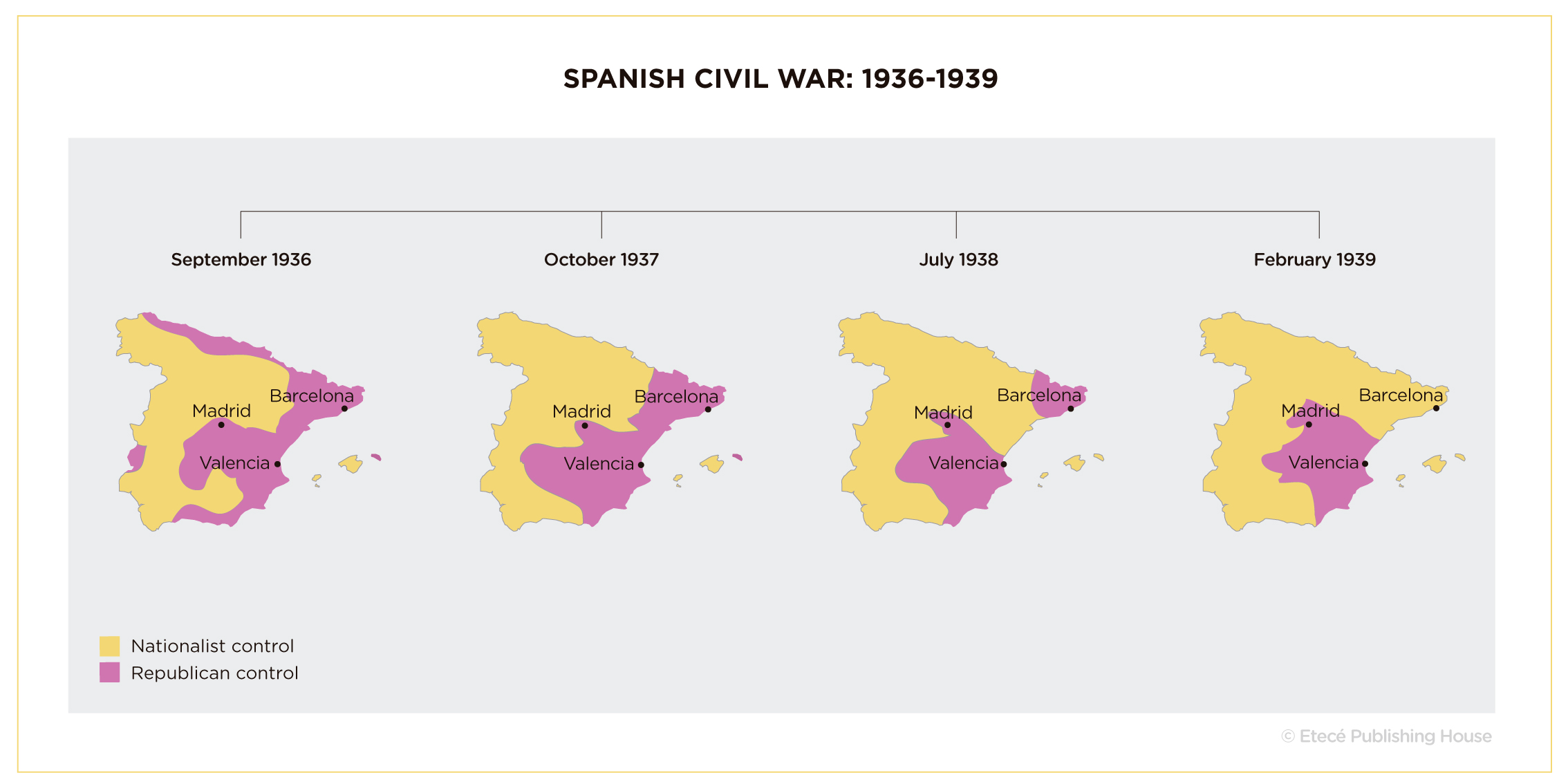
The military revolt that began the Spanish Civil War was led by General Francisco Franco in Melilla, on July 17, 1936. The insurrection spread but did not manage to impose itself throughout the country:
Victories of the revolt
The military insurrection initiated in Melilla and swiftly spread across the entire Morocco protectorate. On July 18 and 19, the coup expanded its reach to the peninsula and the archipelagos, while the government of Casares Quiroga reacted sluggishly to the unfolding events.
The coup succeeded in:
- Galicia, Castilla-León, Navarra.
- Pamplona (western Andalusia) under General Mola.
- Seville and the Balearic Islands (with the exception of Menorca), commanded by Queipo de Llano.
- The Canary Islands, from where Franco, after securing the victory of the coup in the archipelago, relocated to Morocco to lead the Army of Africa.
- Oviedo, under General Aranda.
- Granada, where the assassination of García Lorca took place.
- Zaragoza, under the command of General Cabanellas.
Failures of the revolt
The coup met failure in Asturias, Cantabria, and parts of the Basque Country, where the Basque Nationalist Party (PNV) eventually collaborated with the Republic, as well as in Catalonia, Levante, Madrid, Castilla-La Mancha, Murcia, and the eastern part of Andalusia.
The most resounding defeats occurred in Madrid, where the new president Giral delivered arms to the worker militias, and in Barcelona, where an unusual collaboration of the CNT workers with the Civil Guard and the Assault Guards thwarted the uprising.
Overall, except in Navarra and Castilla-León, the revolt hardly had any popular support and relied on the insurgent military forces. Factors such as uncertainty or the irresolution of the rebels and the authorities charged with suppressing the coup, the capacity for worker mobilization, and the role of the Civil Guard were key to understanding the final outcome of the coup in each region of the country.
The division of the country into two zones: the onset of the civil war
The partial failure of the coup led to the division of the territory into two zones, marking the onset of the war:
- Nationalist zone. The Nationalist zone counted on the cereal and livestock reserves of Castilla and Galicia, as well as on the coal mines in León and Rio Tinto in Huelva. Above all, it boasted a much more prepared army that comprised whole divisions in Castilla, Galicia, and Andalusia, and notably, the Army of Africa, the Legion, and the Regulars.
- Republican zone. The Republican zone encompassed the industrial regions and counted on the wheat supplies in La Mancha and the produce of the Levantine orchards. It also had at its disposal the gold reserves of the Bank of Spain. However, the army units were virtually left disarticulated. Most officers revolted, and the government itself dissolved many units whose loyalty was dubious. The Navy (without many of its commanders) and the Air Force remained under Republican government control.
Republican defeat
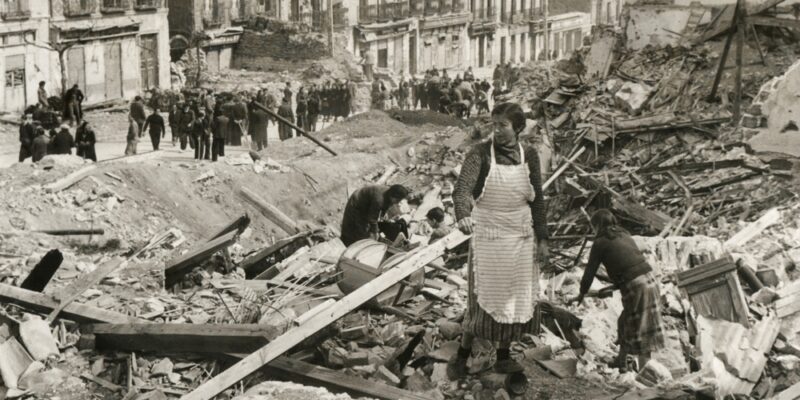
The military superiority of the rebels was gaining the upper hand over the Republican ranks, divided in political factions and devoid of war experience. In 1936, the Nationalists had advanced on Madrid and besieged the city, without being able to take the university area.
During the summer of the following year, they subdued the Basque provinces and later Asturias. After capturing Teruel and gaining access to the Mediterranean in 1938, the Francoists managed to divide the Republic in two, cutting off enemy troops.
A war of attrition thus began, which resulted in famine, misery, and the loss of thousands of lives. Towards the end of that year, they advanced on Catalonia, forcing the Republican troops into exile in France.
In early 1939, the Republican forces dispersed: those who could, went into exile, and the rest began the process of surrender. Franco's forces entered Madrid at the end of March, and by April 1 the war was over.
The National Defense Council
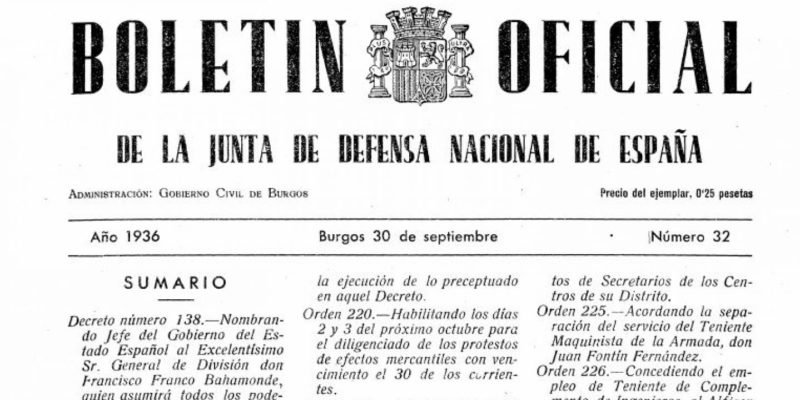
After overthrowing the Republican government in some parts of the country, the insurgents went on to consolidate their forces under a National Defense Council. Their goal was to outlaw the Popular Front party and unions, in addition to banning all forms of workers' or labor union political protests.
At the end of 1936, after conquering Toledo, the council appointed Francisco Franco Generalísimo of the insurgent army and Head of State. In 1939, with the victory over the Republican side, the entire Spanish territory came under the control of the National Defense Council. From then until 1975, General Francisco Franco ruled Spain under a dictatorial regime.
The role of the Catholic Church
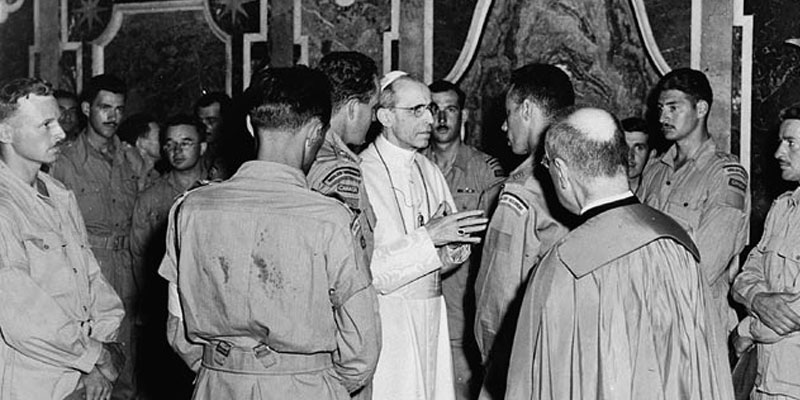
During the Spanish Civil War, the Catholic Church supported the nationalist rebel forces that brought Francisco Franco to power.
Under the Second Republic, the Republican government had established the separation of Church and State, thereby threatening the power of the ecclesiastical hierarchy. Furthermore, within the Republican faction, anarchist and communist groups denounced the power of the Church and its oppression of the people. At the same time, the high religious hierarchy was affected by the reforms established in the secular constitution of the new Republic.
In this context, Catholic institutions supported the formation of the opposition against the Republican government from the start, proclaiming themselves in favor of Franco's uprising. Such is the case of Bishop Pla y Deniel, who made his opinion public, expressing that he viewed the civil war as a "crusade" against "evil" (the Republican government), conducted by the "good" (the coup forces).
Throughout the war, priests and members of the Church were persecuted and killed in the territories controlled by the Republican side.
With Franco's victory in the Civil War, the Catholic Church regained its institutional power and started a strong policy to Christianize Spanish society.
Consequences of the Spanish Civil War
The most significant consequences of the conflict were:
- The establishment of Francoism, a military, nationalist and Catholic dictatorship under Franco's command, which persecuted and tortured its opponents for decades.
- The loss of thousands of lives, including military casualties and summary executions on both sides. Notable deaths by the fascist side included artists and intellectuals, like Federico García Lorca.
- The exile of thousands of Spaniards who fled the conflict or the dictatorship that ensued.
- The destruction and devastation of Spain, which prevented them from participating in World War II and thus reciprocating the favors received from their Nazi and fascist allies.
Francoism
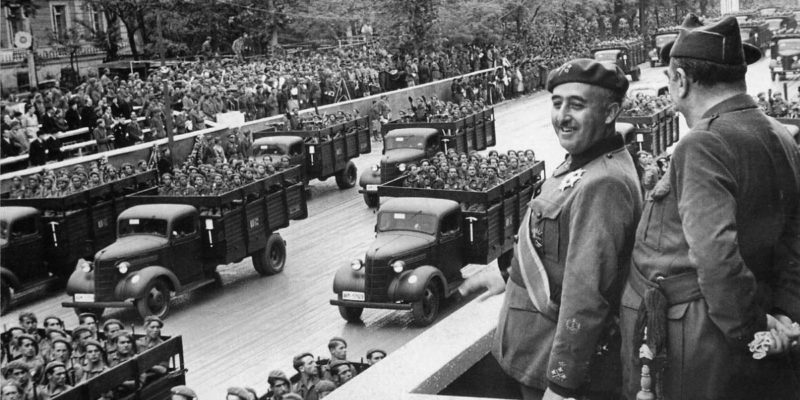
At the end of the Spanish Civil War, the National Defense Council government controlled the entire territory of the country, and the dictatorship of General Francisco Franco was established. The regime lasted until the death of the dictator in 1975, almost forty years later.
During Franco's rule, conservative, liberal and Catholic principles were imposed, with certain traits of German and Italian fascism: social and political control through terror, propaganda, and the elimination of the opposition.
Spanish Civil War in Art

Numerous literary, film and artistic works have portrayed the horror of the Spanish Civil War. Among the most prominent are:
- Paintings such as Guernica by Pablo Picasso, Mercury Fountain by Alexander Calder, and Catalan Peasant in Revolt by Joan Miró.
- Movies including Bicycles Are for the Summer (1984) by Jaime Chávarri, ¡Ay, Carmela! (1990) by Carlos Saura, Buttrefly’s Tongue (1999) by José Luis Cuerda, and The Devil’s Backbone (2001) by Guillermo del Toro.
- Literary works like For Whom the Bell Tolls by Ernest Hemingway, Soldiers of Salamis by Javier Cercas, and The Wall by Jean Paul Sartre.
Explore next:
References
- “Guerra Civil Española”. Wikipedia.
- “Guerra Civil Española”. Profe en Historia.
- “Guerra Civil Española”. Historia de España.
- “¿Cómo empezó la Guerra Civil Española?”. Muy Historia.
- “Resumen. La Guerra Civil Española” (Video). Memorias de Pez.
- “La Guerra Civil Española”. Holocaust Memorial Museum.
- “Spanish Civil War”. The Enciclopaedia Britannica.
Was this information useful to you?
Yes NoThank you for visiting us :)